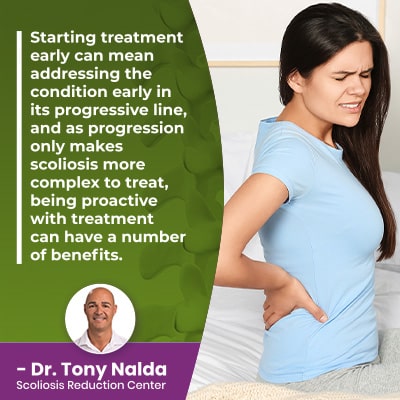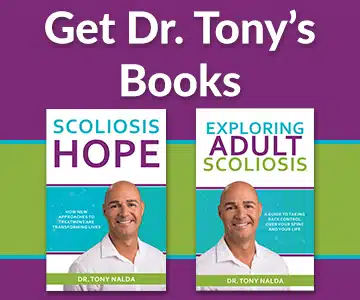Scoliosis is a progressive condition, meaning it has it in its nature to worsen over time, and the milder a condition is when treatment is started, the simpler it is to treat. Scoliosis gets more complex to treat the more it progresses; continue reading to understand why.
While there are no treatment guarantees, with early detection and a proactive treatment response, there are fewer limits to what can be achieved. Early detection increases the likelihood of treatment success because scoliosis is the simplest to treat while mild.
Scoliosis is a highly-prevalent spinal condition, but it’s not always easy to achieve early detection, particularly in children.
Diagnosing Scoliosis
Diagnosing scoliosis means an unnatural spinal curve that bends to the side and also rotates has developed, and it’s the rotational component that makes scoliosis a complex 3-dimensional condition.
Being diagnosed with scoliosis also means being diagnosed with an incurable progressive condition, meaning its nature is to get worse, and only proactive treatment that works towards counteracting the condition’s progressive nature can impact it accordingly.
Although incurable, particularly when detected early, scoliosis can be highly treatable.
Diagnosing scoliosis is achieved through the combination of a physical examination that includes taking a patient’s medical/family history, observing a patient’s posture and gait, and performing an Adam’s forward bend test.
If the physical examination turns up condition indicators, I order an X-ray to truly see what’s happening in and around the spine, and also to confirm a patient’s Cobb angle measurement: a key piece of information.
What’s a Cobb Angle Measurement?
A patient’s Cobb angle measurement is needed for different reasons. In order to reach a diagnosis of scoliosis, another parameter that has to be met is the size of the scoliotic curve.
A scoliosis has to have a minimum Cobb angle measurement of 10 degrees, and this is determined during X-ray by drawing lines from the tops and bottoms of the curve’s most-tilted vertebrae; the resulting angle is expressed in degrees.
A patient’s Cobb angle is also necessary because it’s a key condition characteristic needed to further classify conditions in terms of severity.
The higher a patient’s Cobb angle, the more severe the condition, and the further out of alignment the spine is:
- Mild scoliosis: Cobb angle measurement of between 10 and 25 degrees
- Moderate scoliosis: Cobb angle measurement of between 25 and 40 degrees
- Severe scoliosis: Cobb angle measurement of 40+ degrees
- Very-severe scoliosis: Cobb angle measurement of 80+ degrees
The complex and highly-variable nature of scoliosis necessitates the customization of effective treatment plans.
Why is the Early Detection of Scoliosis Important?
As a progressive condition, scoliosis isn’t static; it’s always changing.

The longer scoliosis is left untreated, the more likely it is to progress because its progression is unimpeded.
We don’t fully understand why most cases of scoliosis develop, but we do understand what makes scoliosis progress: growth and development.
So when it comes to diagnosing scoliosis in children, we know they are more at risk for continued progression than adults because they are still growing.
Scoliosis affects all ages but is most commonly diagnosed in children, and the most-prevalent type of scoliosis is adolescent idiopathic scoliosis, diagnosed between the ages of 10 and 18.
Adolescents are most at risk for rapid-phase progression because of the stage of puberty and its rapid and unpredictable growth spurts.
The main effect of scoliosis in children is postural deviation, but these changes can be subtle, especially when mild, and the main effect of scoliosis in adults is pain, and this is because scoliosis becomes a compressive condition in adulthood.
Once skeletal maturity has been reached, the lengthening motion of a growing spine no longer counteracts the compressive force of the unnatural spinal curve, and this is what makes scoliosis painful in those who have reached skeletal maturity, but not in children.
Because scoliosis isn’t always painful for children, and its effects can be subtle, it can be difficult to achieve early detection, but early detection means diagnosing a condition while mild, and this means the choice to start proactive treatment is there, with its potential benefits.
Scoliosis Progressing
The main benefit involving early detection involves treatment, so let’s explore what happens as scoliosis is progressing, and why starting treatment earlier can help.
When scoliosis is progressing, the size of the unnatural spinal curve is increasing, and this means the condition’s uneven forces are increasing, as are their effects.
As the scoliotic curve is getting larger, it’s getting more rigid, making it less responsive to treatment, and making it difficult for some patients to perform key therapeutic exercises as part of treatment.
In fact, in many of my adult patients who receive their diagnosis later in life after significant progression has already occurred, it’s common that I have to do some preparatory work to establish a baseline level of spinal flexibility before I can start the regular course of treatment.
As scoliosis progresses, the condition is getting more severe, and the ways it affects the body is going to be more noticeable.
In children, postural deviation such as uneven shoulders, shoulder blades, hips, the development of a rib arch, an even waistline, and arms and legs that appear to hang at different lengths are going to become more overt; changes to balance, coordination, and gait are also common.
In adults, they also can experience postural deviation such as a prominent lean to one side, but because the condition is compressive, as progression occurs, the main effect is going to be increasing spinal instability and pain.
Scoliosis pain for adults can involve localized back pain and/or pain that radiates into the extremities due to nerve compression.
As scoliosis progresses, the condition’s effects are going to become more severe, noticeable, and likely to disrupt a patient’s quality of life.
As a progressive condition, scoliosis can’t be cured, but it can be highly treatable, especially if detected early and responded to proactively.
Proactive Conservative Scoliosis Treatment

Traditional scoliosis treatment offers patients a surgical response, but spinal surgery is invasive and risky, and modern conservative treatment offers patients a non-surgical treatment alternative that’s less invasive, costly, and most importantly, is better for long-term spinal health and function.
Here at the Scoliosis Reduction Center®, in an effort to be proactive and work towards preventing progression, increasing condition severity, and the need for invasive surgical treatment, I start treatment as close to the time of diagnosis as possible.
Starting treatment early can mean addressing the condition early in its progressive line, and as progression only makes scoliosis more complex to treat, being proactive with treatment can have a number of benefits.
It’s far more effective to work towards preventing progression and increasing condition effects than it is to attempt to work towards reversing those effects once they’re established.
Here at the Center, I integrate multiple condition-specific treatment disciplines so conditions are impacted on every level, and this includes chiropractic care, physical therapy, corrective braving, and rehabilitation.
Chiropractic care can work towards impacting the condition on a structural level in the form of a curvature reduction.
Physical therapy and scoliosis-specific exercises (SSEs) can help by increasing core strength so the spine’s surrounding muscles can optimally support it, improving posture, addressing any related muscle imbalance, and activating certain areas of the brain for improved brain-body communication.
Corrective bracing can be particularly effective on growing spines, so is a common facet of treatment for adolescent idiopathic scoliosis, and rehabilitation can involve continued chiropractic care and a series of custom-prescribed home exercises to further stabilize and heal the spine.
Conclusion
While treatment success is never guaranteed and can still be achieved without early detection, the chances of treatment success are higher when a condition is detected early and responded to with a proactive treatment plan.
The benefits of early detection, however, aren’t available to those on the path of traditional scoliosis treatment because it doesn’t include a strategy for addressing scoliosis while mild, which is precisely when it’s likely to be the most responsive.
Here at the Center, I educate patients on the benefit of early detection and want to empower the public with information; Scoliosis Hope was written for that reason.
Because the different treatment approaches can affect the spine so differently, I want patients to be aware of all treatment options available to them, and to fully understand how each can affect long-term spinal health and function.
Conservative treatment relies on a more-natural treatment approach that’s aligned with the spine’s movement-based design, while traditional treatment offers an invasive surgical response that’s associated with a weaker spine with a reduced range of motion.




